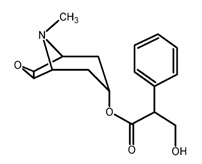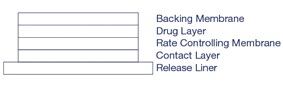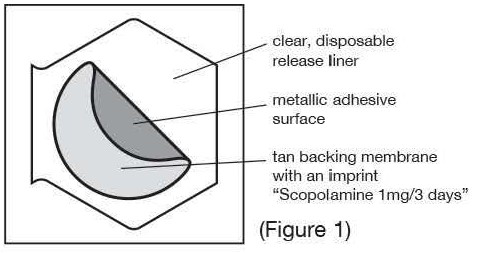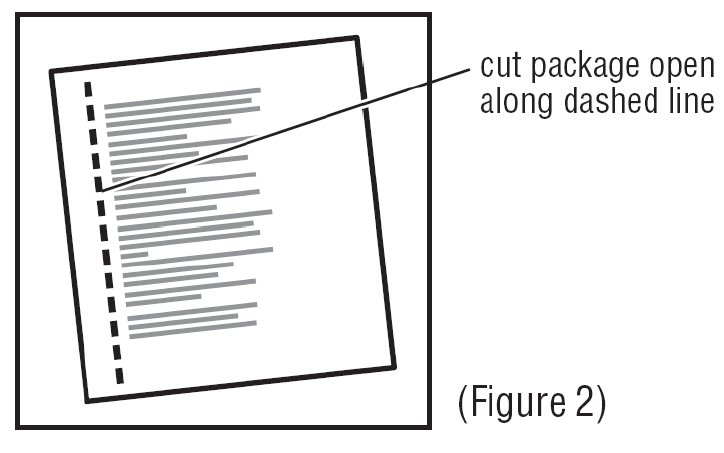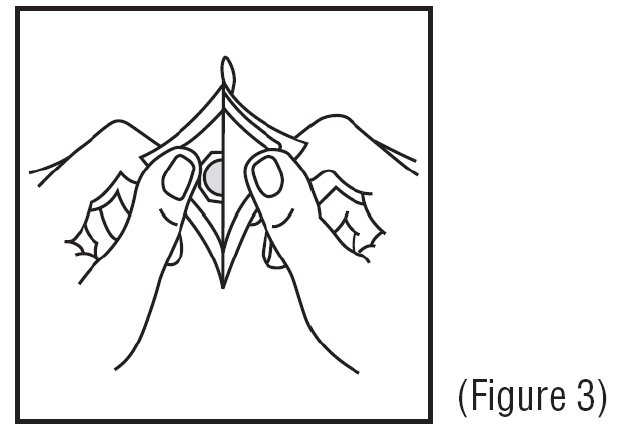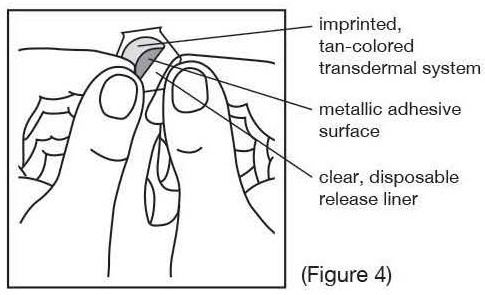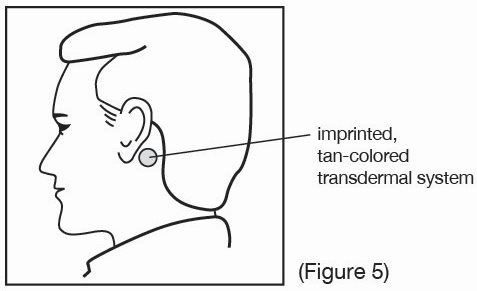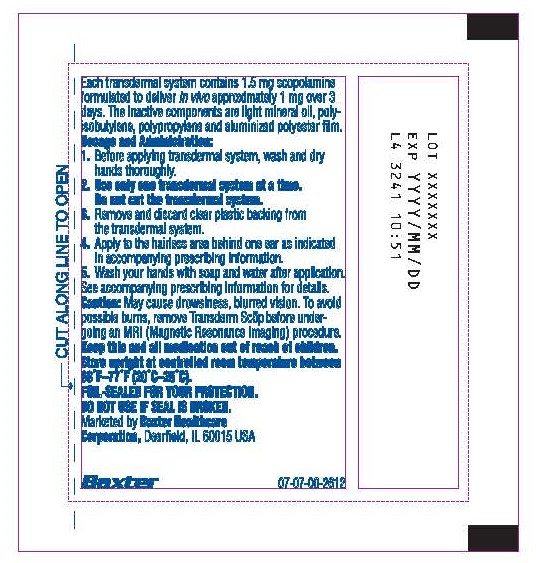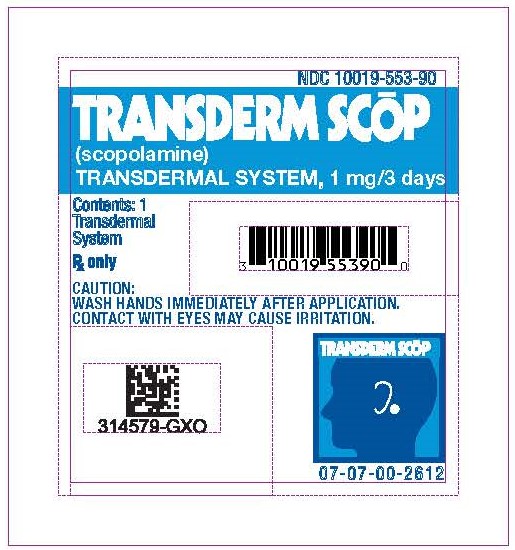Transderm Scop: Package Insert / Prescribing Info
Package insert / product label
Generic name: scopolamine
Dosage form: patch, extended release
Drug classes: Anticholinergic antiemetics, Anticholinergics / antispasmodics
Medically reviewed by Drugs.com. Last updated on Jun 29, 2025.
On This Page
- Indications and Usage
- Dosage and Administration
- Dosage Forms and Strengths
- Contraindications
- Warnings and Precautions
- Adverse Reactions/Side Effects
- Drug Interactions
- Use In Specific Populations
- Drug Abuse and Dependence
- Overdosage
- Description
- Clinical Pharmacology
- Nonclinical Toxicology
- Clinical Studies
- How Supplied/Storage and Handling
- Patient Counseling Information
Highlights of Prescribing Information
TRANSDERM SCŌP (scopolamine transdermal system)
Initial U.S. Approval: 1979
Recent Major Changes
Warnings and Precautions, Hyperthermia (5.5) 4/2025
Indications and Usage for Transderm Scop
Transderm Scop Dosage and Administration
Application and Removal (2.1):
- •
- Each TRANSDERM SCŌP transdermal system delivers 1 mg of scopolamine over 3 days.
- •
- Only wear one transdermal system at a time.
- •
- Do not cut the transdermal system.
- •
- Wash hands thoroughly with soap and water after application.
- •
- Avoid touching or applying pressure to the transdermal system once applied.
- •
- Upon removal, fold used transdermal system in half with sticky side together, discard to prevent accidental contact or ingestion, and wash the hands and application site with soap and water.
Recommended Dosage:
- •
- Motion Sickness: Apply one transdermal system to the hairless area behind one ear at least 4 hours before antiemetic effect is required for use up to 3 days. If therapy for more than 3 days is required, remove the first transdermal system and apply a new transdermal system behind the other ear. (2.2)
- •
- PONV: For surgeries other than cesarean section, apply one transdermal system behind the ear the evening before surgery and remove 24 hours following surgery. (2.2)
Dosage Forms and Strengths
Transdermal system: 1 mg/3 days (3)
Contraindications
Warnings and Precautions
- •
- Acute Angle Closure Glaucoma: Monitor for increased intraocular pressure in patients with open-angle glaucoma and adjust glaucoma therapy as needed. Discontinue if signs or symptoms of acute angle closure glaucoma develop. (5.1)
- •
- Neuropsychiatric Adverse Reactions: May cause psychiatric and cognitive effects, seizures and impair mental and/or physical abilities. Monitor patients for new or worsening psychiatric symptoms during treatment and during concomitant treatment with other drugs that are associated with similar psychiatric effects. (5.2, 7.1)
- •
- Eclamptic Seizures in Pregnant Women: Avoid use in patients with severe preeclampsia. (5.3)
- •
- Gastrointestinal and Urinary Disorders: Consider more frequent monitoring during treatment in patients suspected of having intestinal obstruction; patients with pyloric obstruction, patients with impeded urine flow or receiving other anticholinergic drugs. Discontinue if patient develops difficulty in urination. (5.4, 7.2)
- •
- Hyperthermia: Serious adverse reactions have been reported postmarketing in adult and pediatric patients, including fatal cases. If symptoms occur, remove the transdermal system, and contact a healthcare provider. (5.5)
- •
- Drug Withdrawal/Post-Removal Symptoms: Anticholinergic symptoms may occur 24 hours or more after removal of the transdermal system. (5.6)
- •
- Blurred Vision: Avoid contact with the eyes. (2.1, 5.7)
- •
- Magnetic Resonance Imaging (MRI) Skin Burns: Remove TRANSDERM SCŌP prior to MRI scan. (5.8)
Adverse Reactions/Side Effects
Most common adverse reactions are:
- •
- Motion Sickness (>15%): dry mouth, drowsiness, blurred vision and dilation of the pupils. (6.1)
- •
- PONV (≥ 3%): dry mouth, dizziness, somnolence, agitation, visual impairment, confusion, mydriasis and pharyngitis. (6.1)
To report SUSPECTED ADVERSE REACTIONS, contact Baxter Healthcare Corporation at 1-866-888-2472 or FDA at 1-800-FDA-1088 or www.fda.gov/medwatch.
Drug Interactions
- •
- Drugs Causing Central Nervous System (CNS) Adverse Reactions: Monitor patients for CNS adverse reactions (drowsiness, dizziness or disorientations). (7.1)
- •
- Anticholinergic Drugs: Consider more frequent monitoring during treatment in patients receiving other anticholinergic drugs. (7.2)
- •
- Oral Drugs Absorbed in the Stomach: Monitor for increased or decreased therapeutic effect of the oral drug. (7.3)
- •
- Interaction with Gastric Secretion Test: Discontinue use of TRANSDERM SCŌP 10 days prior to testing. (7.4)
Use In Specific Populations
See 17 for PATIENT COUNSELING INFORMATION and FDA-approved patient labeling.
Revised: 6/2025
Full Prescribing Information
1. Indications and Usage for Transderm Scop
TRANSDERM SCŌP is indicated in adults for the prevention of:
- •
- nausea and vomiting associated with motion sickness.
- •
- post-operative nausea and vomiting (PONV) associated with recovery from anesthesia and/or opiate analgesia and surgery.
2. Transderm Scop Dosage and Administration
2.1 Important Application and Removal Instructions
- •
- Each TRANSDERM SCŌP transdermal system is formulated to deliver in vivo approximately 1 mg of scopolamine over 3 days.
- •
- Only wear one transdermal system at any time.
- •
- Do not cut the transdermal system.
- •
- Apply the transdermal system to the skin in the postauricular area (hairless area behind one ear).
- •
- After the transdermal system is applied on the dry skin behind the ear, wash hands thoroughly with soap and water and dry hands [see Warnings and Precautions (5.7)].
- •
- If the transdermal system becomes displaced, discard the transdermal system, and apply a new transdermal system on the hairless area behind the other ear.
- •
- Once the transdermal system has been affixed, avoid touching or applying pressure to the transdermal system while it is being worn, since pressure exerted on it may cause scopolamine to ooze out at the edge.
- •
- Upon removal, fold the used transdermal system in half with the sticky side together, and discard in household trash in a manner that prevents accidental contact or ingestion by children, pets or others.
- •
- Wash the hands and application site with soap and water after transdermal system removal [see Warnings and Precautions (5.7)].
2.2 Recommended Adult Dosage
Motion Sickness
Apply one TRANSDERM SCŌP transdermal system to the hairless area behind one ear at least 4 hours before the antiemetic effect is required – for use up to 3 days. If therapy is required for longer than 3 days, remove the first transdermal system and apply a new TRANSDERM SCŌP transdermal system behind the other ear.
PONV
For surgeries other than cesarean section: Apply one TRANSDERM SCŌP transdermal system the evening before scheduled surgery. Remove the transdermal system 24 hours following surgery.
3. Dosage Forms and Strengths
Transdermal system: a circular, flat, tan-colored transdermal system imprinted with “SCOP 1 mg/3 days”
4. Contraindications
TRANSDERM SCŌP is contraindicated in patients with:
- •
- angle closure glaucoma [see Warnings and Precautions (5.1)].
- •
- hypersensitivity to scopolamine or other belladonna alkaloids or to any ingredient or component in the formulation or delivery system. Reactions have included rash generalized and erythema [see Adverse Reactions (6.2), Description (11)].
5. Warnings and Precautions
5.1 Acute Angle Closure Glaucoma
The mydriatic effect of scopolamine may cause an increase in intraocular pressure resulting in acute angle closure glaucoma. Monitor intraocular pressure in patients with open angle glaucoma and adjust glaucoma therapy during TRANSDERM SCŌP use, as needed. Advise patients to immediately remove the transdermal system and contact their healthcare provider if they experience symptoms of acute angle closure glaucoma (e.g., eye pain or discomfort, blurred vision, visual halos or colored images in association with red eyes from conjunctival congestion and corneal edema).
5.2 Neuropsychiatric Adverse Reactions
Psychiatric Adverse Reactions
Scopolamine has been reported to exacerbate psychosis. Other psychiatric reactions have also been reported, including acute toxic psychosis, agitation, speech disorder, hallucinations, paranoia, and delusions [see Adverse Reactions (6.2)]. Monitor patients for new or worsening psychiatric symptoms during treatment with TRANSDERM SCŌP. Also, monitor patients for new or worsening psychiatric symptoms during concomitant treatment with other drugs that are associated with similar psychiatric effects [see Drug Interactions (7.1)]. In cases of psychiatric reactions occurring TRANSDERM SCŌP should be removed at once. If, despite this, the symptoms persist in a severe form, instruct patients to seek medical attention.
Seizures
Seizures and seizure-like activity have been reported in patients receiving scopolamine. Weigh this potential risk against the benefits before prescribing TRANSDERM SCŌP to patients with a history of seizures, including those receiving anti-epileptic medication or who have risk factors that can lower the seizure threshold.
Cognitive Adverse Reactions
Scopolamine can cause drowsiness, disorientation, and confusion. Discontinue TRANSDERM SCŌP if signs or symptoms of cognitive impairment develop. If, despite this, the symptoms persist in a severe form, instruct patients to seek medical attention. Elderly and pediatric patients may be more sensitive to the neurological and psychiatric effects of TRANSDERM SCŌP. Consider more frequent monitoring during treatment with TRANSDERM SCŌP in elderly patients [see Use in Specific Populations (8.5)]. TRANSDERM SCŌP is not approved for use in pediatric patients [see Use in Specific Populations (8.4)].
Hazardous Activities
TRANSDERM SCŌP may impair the mental and/or physical abilities required for the performance of hazardous tasks such as driving a motor vehicle, operating machinery or participating in underwater sports. Concomitant use of other drugs that cause central nervous system (CNS) adverse reactions (e.g., alcohol, sedatives, hypnotics, opiates, and anxiolytics) or have anticholinergic properties (e.g., other belladonna alkaloids, sedating antihistamines, meclizine, tricyclic antidepressants, and muscle relaxants) may increase this effect [see Drug Interactions (7.1)]. Inform patients not to operate motor vehicles or other dangerous machinery or participate in underwater sports until they are reasonably certain that TRANSDERM SCŌP does not affect them adversely.
5.3 Eclamptic Seizures in Pregnant Women
Eclamptic seizures have been reported in pregnant women with severe preeclampsia soon after injection of intravenous and intramuscular scopolamine [see Use in Specific Populations (8.1)]. Avoid use of TRANSDERM SCŌP in patients with severe preeclampsia.
5.4 Gastrointestinal and Urinary Disorders
Scopolamine, due to its anticholinergic properties, can decrease gastrointestinal motility and cause urinary retention. Consider more frequent monitoring during treatment with TRANSDERM SCŌP in patients suspected of having intestinal obstruction, patients with pyloric obstruction or patients with impeded flow of urine (e.g., in diseases of the prostate or urinary bladder neck obstruction) and patients receiving other anticholinergic drugs [see Drug Interactions (7.2)]. Discontinue TRANSDERM SCŌP in patients who develop difficulty in urination.
5.5 Hyperthermia
Serious adverse reactions of hyperthermia have been reported postmarketing in adult and pediatric patients receiving transdermal scopolamine, including fatal cases. Anticholinergic agents, including scopolamine, can increase core body temperature and reduce sweating, which may cause further increases in body temperature. Hyperthermia may be exacerbated by exposure to external heat sources or high environmental temperature. Pediatric and geriatric patients may be more susceptible to these anticholinergic effects on thermoregulation. Advise patients if body temperature increases, or they are not sweating in warm environmental conditions, to remove the transdermal system and contact their healthcare provider. Symptoms may persist following removal of the used transdermal system as there may be continued systemic absorption of scopolamine through the skin. TRANSDERM SCŌP is not approved for use in pediatric patients [see Use in Specific Populations (8.4, 8.5)].
5.6 Drug Withdrawal/Post-Removal Symptoms
Discontinuation of TRANSDERM SCŌP, usually after several days of use, may result in withdrawal symptoms, such as disturbances of equilibrium, dizziness, nausea, vomiting, abdominal cramps, sweating, headache, mental confusion, muscle weakness, bradycardia and hypotension. The onset of these symptoms is generally 24 hours or more after the transdermal system has been removed. Instruct patients to seek medical attention if they experience severe symptoms.
5.7 Blurred Vision
Scopolamine can cause temporary dilation of the pupils resulting in blurred vision if it comes in contact with the eyes.
Advise patients to wash their hands thoroughly with soap and water and dry their hands immediately after handling the transdermal system, do not touch the system while wearing it, and wash hands and the application site with soap and water after transdermal system removal [see Dosage and Administration (2.1)].
6. Adverse Reactions/Side Effects
The following serious adverse reactions are described elsewhere in labeling:
- •
- Acute Angle Closure Glaucoma [see Warnings and Precautions (5.1)]
- •
- Neuropsychiatric Adverse Reactions [see Warnings and Precautions (5.2)]
- •
- Eclamptic Seizures in Pregnant Women [see Warnings and Precautions (5.3)]
- •
- Gastrointestinal and Urinary Disorders [see Warnings and Precautions (5.4)]
- •
- Hyperthermia [see Warnings and Precautions (5.5)]
- •
- Drug Withdrawal/Post-Removal Symptoms [see Warnings and Precautions (5.6)]
- •
- Blurred Vision [see Warnings and Precautions (5.7)]
- •
- MRI Skin Burns [see Warnings and Precautions (5.8)]
6.1 Clinical Trials Experience
Because clinical trials are conducted under widely varying conditions, adverse reaction rates observed in the clinical trials of a drug cannot be directly compared to rates in the clinical trials of another drug and may not reflect the rates observed in practice.
Motion Sickness
The most common adverse reaction (approximately two thirds) was dry mouth. Less common adverse reactions, included drowsiness (less than one sixth), blurred vision and dilation of the pupils.
PONV
Common adverse reactions, occurring in at least 3% of patients in PONV clinical trials are shown in Table 1.
| *occurring in at least 3% of patients and at a rate higher than placebo | ||
|
TRANSDERM SCŌP |
Placebo |
|
|
Dry mouth |
29 |
16 |
|
Dizziness |
12 |
7 |
|
Somnolence |
8 |
4 |
|
Agitation |
6 |
4 |
|
Visual Impairment |
5 |
3 |
|
Confusion |
4 |
3 |
|
Mydriasis |
4 |
0 |
|
Pharyngitis |
3 |
2 |
6.2 Postmarketing Experience
The following adverse reactions have been identified during post-approval use of scopolamine transdermal system. Because these reactions are reported voluntarily from a population of uncertain size, it is not always possible to reliably estimate their frequency or establish a causal relationship to drug exposure.
Psychiatric disorders: acute psychosis including: disorientation, hallucinations, and paranoia
Nervous system disorders: amnesia, coordination abnormalities, disturbance in attention, headache, restlessness, speech disorder
General disorders and administration site conditions: application site reactions (including blistering, burning, pruritus, and rash) and hyperthermia
Eye disorders: amblyopia, angle closure glaucoma, dry eyes, eyelid irritation, eye pruritus
Skin and subcutaneous tissue disorders: erythema, rash generalized, skin irritation
Renal and urinary disorders: dysuria
Ear and labyrinth disorders: vertigo
Related/similar drugs
Benadryl
Benadryl is an antihistamine and is used to treat sneezing, runny nose, itching and other ...
Phenergan
Phenergan (promethazine) is used to treat allergy symptoms and prevent motion sickness. Includes ...
Botox
Botox is used cosmetically to reduce facial lines and wrinkles and for medical purposes for ...
Antivert
Antivert (meclizine) is used to treat or prevent nausea, vomiting, and dizziness caused by motion ...
Banophen
Banophen is used for allergic reactions, allergic rhinitis, cold symptoms, cough, extrapyramidal ...
Benadryl Allergy
Benadryl Allergy is used for allergic reactions, allergic rhinitis, allergies, cold symptoms ...
Ginger
Ginger is used for herbal supplementation, motion sickness, nausea/vomiting
Dimenhydrinate
Dimenhydrinate is used for insomnia, meniere's disease, motion sickness, nausea/vomiting
Promethazine
Promethazine is a phenothiazine and antihistamine used to treat allergies, motion sickness, nausea ...
7. Drug Interactions
7.1 Drugs Causing Central Nervous System (CNS) Adverse Reactions
The concurrent use of TRANSDERM SCŌP with other drugs that cause CNS adverse reactions of drowsiness, dizziness or disorientation (e.g., sedatives, hypnotics, opiates, anxiolytics and alcohol) or have anticholinergic properties (e.g., other belladonna alkaloids, sedating antihistamines, meclizine, tricyclic antidepressants, and muscle relaxants) may potentiate the effects of TRANSDERM SCŌP [see Warnings and Precautions (5.2)]. Either TRANSDERM SCŌP or the interacting drug should be chosen, depending on the importance of the drug to the patient. If the interacting drug cannot be avoided, monitor patients for CNS adverse reactions.
7.2 Anticholinergic Drugs
Concomitant use of scopolamine with other drugs having anticholinergic properties may increase the risk of CNS adverse reactions [see Drug Interactions (7.1)], intestinal obstruction and/or urinary retention. Consider more frequent monitoring during treatment with TRANSDERM SCŌP in patients receiving anticholinergic drugs [see Warnings and Precautions (5.2, 5.4)].
7.3 Oral Drugs Absorbed in the Stomach
TRANSDERM SCŌP, as an anticholinergic, may delay gastric and upper gastrointestinal motility and, therefore, the rate of absorption of other orally administered drugs. Monitor patients for modified therapeutic effect of concomitant orally administered drugs with a narrow therapeutic index.
8. Use In Specific Populations
8.1 Pregnancy
Risk Summary
Eclamptic seizures have been reported in pregnant women with severe preeclampsia soon after injection of intravenous or intramuscular scopolamine. Avoid use of TRANSDERM SCOP in patients with severe preeclampsia [see Warnings and Precautions (5.3) and Data]. Available data from observational studies and postmarketing reports with scopolamine use in pregnant women have not identified a drug associated risk of major birth defects, miscarriage, or adverse fetal outcomes.
In animal studies, there was no evidence of adverse developmental effects with intravenous administration of scopolamine hydrobromide revealed in rats. Embryotoxicity was observed in rabbits at intravenous doses producing plasma levels approximately 100 times the levels achieved in humans using a transdermal system.
The background risk of major birth defects and miscarriage for the indicated population is unknown. All pregnancies have a background risk of birth defect, loss, or other adverse outcomes. In the U.S. general population, the background risk of major birth defects and miscarriage in clinically recognized pregnancies is 2% to 4% and 15% to 20%, respectively.
Data
Human Data
In published case reports, two pregnant patients with severe preeclampsia were administered intravenous and intramuscular scopolamine, respectively, and developed eclamptic seizures soon after scopolamine administration [see Warnings and Precautions (5.3)].
Animal Data
In animal reproduction studies, when pregnant rats and rabbits received scopolamine hydrobromide by daily intravenous injection, no adverse effects were observed in rats. An embryotoxic effect was observed in rabbits at doses producing plasma levels approximately 100 times the levels achieved in humans using a transdermal system. Scopolamine administered parenterally to rats and rabbits at doses higher than the dose delivered by TRANSDERM SCŌP did not affect uterine contractions or increase the duration of labor.
8.2 Lactation
Risk Summary
Scopolamine is present in human milk. There are no available data on the effects of scopolamine on the breastfed infant or the effects on milk production. The developmental and health benefits of breastfeeding should be considered along with the mother’s clinical need for TRANSDERM SCŌP and any potential adverse effects on the breastfed child from TRANSDERM SCŌP or from the underlying maternal condition.
8.4 Pediatric Use
The safety and effectiveness of TRANSDERM SCŌP have not been established in pediatric patients. Pediatric patients are particularly susceptible to the anticholinergic adverse reactions of scopolamine, including neurologic and psychiatric adverse reactions and drug withdrawal syndrome. Serious adverse reactions of acute psychosis (e.g., disorientation, hallucinations), amblyopia, hyperthermia (including a fatal case), and mydriasis have also been reported in pediatric patients [see Warnings and Precautions (5.2, 5.5)].
8.5 Geriatric Use
Clinical trials of TRANSDERM SCŌP did not include sufficient number of subjects aged 65 years and older to determine if they respond differently from younger subjects. In other clinical experience, elderly patients had an increased risk of neurologic and psychiatric adverse reactions, such as hallucinations, confusion, dizziness and drug withdrawal syndrome [see Warnings and Precautions (5.2, 5.6)]. Consider more frequent monitoring for CNS adverse reactions during treatment with TRANSDERM SCŌP in geriatric patients [see Warnings and Precautions (5.2)].
Serious adverse reactions of hyperthermia have been reported postmarketing in geriatric patients receiving transdermal scopolamine, including a fatal case. Geriatric patients may be more susceptible to the anticholinergic effects of disruption in thermoregulation. Advise patients if body temperature increases, or they are not sweating in warm environmental conditions, to remove the transdermal system and contact their healthcare provider [see Warnings and Precautions (5.5)].
8.6 Renal or Hepatic Impairment
TRANSDERM SCŌP has not been studied in patients with renal or hepatic impairment. Consider more frequent monitoring during treatment with TRANSDERM SCŌP in patients with renal or hepatic impairment because of the increased risk of CNS adverse reactions [see Warnings and Precautions (5.2)].
9. Drug Abuse and Dependence
9.3 Dependence
Termination of TRANSDERM SCŌP, usually after several days of use, may result in withdrawal symptoms such as disturbances of equilibrium, dizziness, nausea, vomiting, abdominal cramps, sweating, headache, mental confusion, muscle weakness, bradycardia and hypotension. These withdrawal symptoms indicate that scopolamine, like other anticholinergic drugs, may produce physical dependence. The onset of these symptoms, generally 24 hours or more after the transdermal system has been removed, can be severe and may require medical intervention [see Warnings and Precautions (5.6)].
10. Overdosage
Anticholinergic toxicity includes both central and peripheral signs and symptoms: agitation, central nervous system effects (e.g., coma, confusion, hallucinations, lethargy, seizures, somnolence), decreased bowel sounds, dry flushed skin, dry mouth, hyperthermia, hypertension, supraventricular arrhythmias, tachycardia, urinary retention, visual disturbances (e.g., amblyopia, mydriasis). These symptoms can be severe and may require medical intervention.
In cases of toxicity remove the TRANSDERM SCŌP transdermal system. Serious symptomatic cases of overdosage involving multiple transdermal system applications and/or ingestion may be managed by initially ensuring the patient has an adequate airway and supporting respiration and circulation. This should be rapidly followed by removal of all transdermal systems from the skin and the mouth. If there is evidence of transdermal system ingestion, endoscopic removal of swallowed transdermal systems, or administration of activated charcoal should be considered, as indicated by the clinical situation. In any case where there is serious overdosage or signs of evolving acute toxicity, continuous monitoring of vital signs and ECG, establishment of intravenous access, and administration of oxygen are all recommended.
The signs and symptoms of overdose/toxicity due to scopolamine should be carefully distinguished from the occasionally observed syndrome of withdrawal [see Warnings and Precautions (5.6)]. Although mental confusion and dizziness may be observed with both acute toxicity and withdrawal, other characteristic findings differ: tachyarrhythmias, dry skin, and decreased bowel sounds suggest anticholinergic toxicity, while bradycardia, headache, nausea and abdominal cramps, and sweating suggest post-removal withdrawal.
If over-exposure occurs, call the Poison Help line at 1-800-222-1222 for current information on the management of poisoning or overdosage.
11. Transderm Scop Description
TRANSDERM SCŌP (scopolamine transdermal system) is designed for continuous release of scopolamine following application to an area of intact skin on the head, behind the ear. Each system contains 1.3 mg of scopolamine base. Scopolamine is (9-methyl-3-oxa-9-azatricyclo[3.3.1.02,4]nonan-7-yl) 3-hydroxy-2-phenylpropanoate. The empirical formula is C17H21NO4 and its structural formula is:
Scopolamine has a molecular weight of 303.35 and a pKa of 7.55-7.81. The TRANSDERM SCŌPtransdermal system is a circular, 0.2 mm thick, 2.5 cm2 film with four layers. Proceeding from the visible surface towards the surface attached to the skin, these layers are: (1) a backing membrane of tan-colored, aluminized, polyester film; (2) a drug layer of scopolamine, crospovidone, isopropyl palmitate, light mineral oil, and polyisobutylene; (3) an ethylene vinyl acetate copolymer membrane that controls the rate of delivery of scopolamine from the system to the skin surface; and (4) a contact layer formulation of crospovidone, isopropyl palmitate, light mineral oil, polyisobutylene, and scopolamine. A release liner of siliconized polyester, which covers the adhesive layer, is removed before the system is used.
Cross section of the system:
12. Transderm Scop - Clinical Pharmacology
12.1 Mechanism of Action
Scopolamine, a belladonna alkaloid, is an anticholinergic. Scopolamine acts: i) as a competitive inhibitor at postganglionic muscarinic receptor sites of the parasympathetic nervous system, and ii) on smooth muscles that respond to acetylcholine but lack cholinergic innervation. It has been suggested that scopolamine acts in the central nervous system (CNS) by blocking cholinergic transmission from the vestibular nuclei to higher centers in the CNS and from the reticular formation to the vomiting center. Scopolamine can inhibit the secretion of saliva and sweat, decrease gastrointestinal secretions and motility, cause drowsiness, dilate the pupils, increase heart rate, and depress motor function.
12.3 Pharmacokinetics
The system is formulated to deliver approximately 1 mg of scopolamine to the systemic circulation over 3 days.
Absorption
Following application to the skin behind the ear, circulating plasma concentrations are detected within 4 hours with peak concentrations being obtained, on average, within 24 hours. The average plasma concentration produced is 87 pg/mL (0.28 nM) for free scopolamine and 354 pg/mL for total scopolamine (free + conjugates). Following removal of the used transdermal system, there is some degree of continued systemic absorption of scopolamine bound in the skin layers.
Distribution
The distribution of scopolamine is not well characterized. It crosses the placenta and the blood brain barrier and may be reversibly bound to plasma proteins.
Elimination
Metabolism and Excretion
Scopolamine is metabolized and conjugated with less than 5% of the total dose appearing unchanged in the urine. The enzymes responsible for metabolizing scopolamine are unknown. The exact elimination pattern of scopolamine has not been determined. Following transdermal system removal, plasma concentrations of scopolamine decline in a log linear fashion with an observed half-life of 9.5 hours. Less than 10% of the total dose is excreted in the urine as the parent drug and metabolites over 108 hours.
Drug Interaction Studies
An in vitro study using human hepatocytes examined the induction of CYP1A2 and CYP3A4 by scopolamine. Scopolamine did not induce CYP1A2 and CYP3A4 isoenzymes at the concentrations up to 10 nM. In an in vitro study using human liver microsomes which evaluated the inhibition of CYP1A2, 2C8, 2C9, 2C19, 2D6 and 3A4, scopolamine did not inhibit these cytochrome P450 isoenzymes at the concentrations up to 1 micromolar. No in vivo drug-drug interaction studies have been conducted.
13. Nonclinical Toxicology
13.1 Carcinogenesis, Mutagenesis, Impairment of Fertility
No long-term studies in animals have been conducted to evaluate the carcinogenic potential of scopolamine. The mutagenic potential of scopolamine has not been evaluated.
Fertility studies were performed in female rats and revealed no evidence of impaired fertility or harm to the fetus due to scopolamine hydrobromide administered by daily subcutaneous injection. Maternal body weights were reduced in the highest-dose group (plasma level approximately 500 times the level achieved in humans using a transdermal system). However, fertility studies in male animals were not performed.
14. Clinical Studies
14.1 Prevention of Motion Sickness
In 195 adult subjects of different racial origins who participated in clinical efficacy studies at sea or in a controlled motion environment, there was a 75% reduction in the incidence of motion-induced nausea and vomiting. TRANSDERM SCŌP was applied from 4 to 16 hours prior to the onset of motion in these studies.
14.2 Prevention of Post-Operative Nausea and Vomiting
A clinical efficacy study evaluated 168 adult female patients undergoing gynecological surgery with anesthesia and opiate analgesia. Patients received TRANSDERM SCŌP or placebo applied approximately 11 hours before anesthesia/opiate analgesia. No retching/vomiting during the 24-hour post-operative period was reported in 79% of those treated with TRANSDERM SCŌP compared to 72% of those receiving placebo. When the need for additional antiemetic medication was assessed during the same period, there was no need for medication in 89% of patients treated with TRANSDERM SCŌP as compared to 72% of placebo-treated patients.
16. How is Transderm Scop supplied
TRANSDERM SCŌP (scopolamine transdermal system) 1 mg/3 days is available as the following:
Cartons of 4, 10, and 24 transdermal systems, packaged into individual foil pouches.
- •
- Carton of 4 transdermal systems. NDC 10019-008-04
- •
- Carton of 10 transdermal systems. NDC 10019-008-10
- •
- Carton of 24 transdermal systems. NDC 10019-008-24
Store at controlled room temperature between 20°C to 25°C (68°F to 77°F).
Store pouch(es) in an upright position.
Do not bend or roll pouch(es).
Wash hands thoroughly with soap and water immediately after handling the transdermal system. Avoid touching the system during the treatment. Upon removal, fold the used transdermal system in half with the sticky side together, and discard in household trash in a manner that prevents accidental contact or ingestion by children, pets or others. Wash the hands and application site with soap and water after transdermal system removal [see Dosage and Administration (2.1), Warnings and Precautions (5.7)].
17. Patient Counseling Information
Advise the patient to read the FDA-approved patient labeling (Patient Information and Instructions for Use).
Administration Instructions
Counsel patients on how to apply and remove the transdermal system [see Dosage and Administration (2.1)]:
- •
- Only wear one transdermal system at any time.
- •
- Do not cut the transdermal system.
- •
- Apply the transdermal system to the skin in the postauricular (hairless area behind one ear) area.
- •
- After the transdermal system is applied on the dry skin behind the ear, wash hands thoroughly with soap and water and dry hands.
- •
- If the transdermal system becomes displaced, discard the transdermal system, and apply a new transdermal system on the hairless area behind the other ear.
- •
- Once the transdermal system has been affixed, avoid touching or applying pressure to the transdermal system, since pressure exerted on it may cause scopolamine to ooze out at the edge.
- •
- Upon removal, fold the used transdermal system in half with the sticky side together, and discard in household trash in a manner that prevents accidental contact or ingestion by children, pets or others.
- •
- Wash the hands and application site with soap and water after transdermal system removal.
Patients with Open-Angle Glaucoma
Advise patients with open-angle glaucoma to remove the TRANSDERM SCŌP transdermal system immediately and contact their healthcare provider if they experience symptoms of acute angle closure glaucoma, including pain and reddening of the eyes, accompanied by dilated pupils, blurred vision and/or seeing halos around lights [see Warnings and Precautions (5.1)].
Neuropsychiatric Adverse Reactions
- •
- Advise patients that psychiatric adverse reactions may occur, especially in patients with a past psychiatric history or in those receiving other drugs also associated with psychiatric effects, and to report to their healthcare provider any new or worsening psychiatric symptoms.
- •
- Advise patients to discontinue TRANSDERM SCŌP and contact a healthcare provider immediately if they experience a seizure.
- •
- Advise patients, especially elderly patients, that cognitive impairment may occur during treatment with TRANSDERM SCŌP, especially in those receiving other drugs also associated with CNS effects, and to report to their healthcare provider if they develop signs or symptoms of cognitive impairment such as hallucinations, confusion or dizziness.
- •
- Inform patients not to operate motor vehicles or other dangerous machinery or participate in underwater sports until they are reasonably certain that TRANSDERM SCŌP does not affect them adversely [see Warnings and Precautions (5.2)].
Decreased Gastrointestinal Motility and Urinary Retention
Instruct patients to remove the transdermal system if they develop symptoms of intestinal obstruction (abdominal pain, nausea or vomiting) or any difficulties in urinating [see Warnings and Precautions (5.4)].
Hyperthermia
Inform patients that TRANSDERM SCŌP can increase body temperature and reduce sweating, which may result in hyperthermia and be exacerbated by exposure to external heat sources or high environmental temperature. Geriatric patients may be more susceptible to these effects. Advise patients if body temperature increases, or they are not sweating in warm environmental conditions, remove the transdermal system, and contact their healthcare provider. Symptoms may persist after removal of the transdermal system [see Warnings and Precautions (5.5)].
Drug Withdrawal/Post-Removal Symptoms
Inform patients that if they remove the TRANSDERM SCŌP transdermal system after several days of use, withdrawal symptoms may occur and to seek immediate medical care if they develop severe symptoms after removing TRANSDERM SCŌP [see Warnings and Precautions (5.6)].
Blurred Vision
Inform patients that temporary dilation of the pupils and blurred vision may occur if TRANSDERM SCŌP comes in contact with the eyes. Instruct patients to wash their hands thoroughly with soap and water immediately after handling the transdermal system, do not touch the system while wearing it, and wash hands and the application site with soap and water after transdermal system removal [see Dosage and Administration (2.1), see Warnings and Precautions (5.7)].
MRI Skin Burns
Instruct patients to remove the TRANSDERM SCŌP transdermal system before undergoing an MRI [see Warnings and Precautions (5.8)].
Marketed by: Baxter Healthcare Corporation
Deerfield, IL 60015 USA
For Product Inquiry 1 800 ANA DRUG (1-800-262-3784)
Trademarks are owned by or licensed to Baxter International Inc. or its subsidiaries.
07-19-00-9783
|
PATIENT INFORMATION TRANSDERM SCŌP (trans-derm skōp) (scopolamine transdermal system) |
|||
|
Read this Patient Information before you start using TRANSDERM SCŌP and each time you get a refill. There may be new information. This information does not take the place of talking to your doctor about your medical condition or your treatment. |
|||
|
What is TRANSDERM SCŌP? TRANSDERM SCŌP is a prescription medicine used for adults to help prevent:
It is not known if TRANSDERM SCŌP is safe and effective in children. |
|||
|
Who should not use TRANSDERM SCŌP? Do not use TRANSDERM SCŌP if you:
|
|||
|
What should I tell my doctor before using TRANSDERM SCŌP? Before you use TRANSDERM SCŌP, tell your doctor about all of your medical conditions, including if you:
Tell your doctor about all the medicines you take, including prescription and over-the-counter medicines, vitamins and herbal supplements. TRANSDERM SCŌP may affect the way other medicines work, and other medicines may affect how TRANSDERM SCŌP works. Medicines that you take by mouth may not be absorbed well while you use TRANSDERM SCŌP. Especially tell your doctor if you take:
Ask your doctor if you are not sure if your medicine is one that is listed above. Know the medicines you take. Keep a list of them and show it to your doctor or pharmacist when you get a new medicine. |
|||
|
How should I use TRANSDERM SCŌP?
|
|||
|
What should I avoid while using TRANSDERM SCŌP?
|
|||
|
What are the possible side effects of TRANSDERM SCŌP? TRANSDERM SCŌP may cause serious side effects, including:
The most common side effects of using TRANSDERM SCŌP include: |
|||
|
|
|
|
|
|
| |
|
Tell your doctor if you have any side effect that bothers you or that does not go away. These are not all the possible side effects of TRANSDERM SCŌP. Call your doctor for medical advice about side effects. You may report side effects to FDA at 1-800-FDA-1088. |
|||
|
General information about the safe and effective use of TRANSDERM SCŌP. Medicines are sometimes prescribed for purposes other than those listed in a patient information leaflet. Do not use TRANSDERM SCŌP for a condition for which it was not prescribed. Do not give TRANSDERM SCŌP to other people, even if they have the same symptoms you have. It may harm them. You can ask your pharmacist or doctor for information about TRANSDERM SCŌP that is written for health professionals. |
|||
|
What are the ingredients in TRANSDERM SCŌP? Active ingredient: scopolamine Inactive ingredients: crospovidone, isopropyl palmitate, light mineral oil, polyisobutylene, ethylene vinyl acetate copolymer and aluminized polyester film Deerfield, IL 60015 USA
|
|||
INSTRUCTIONS FOR USE
TRANSDERM SCŌP (trans-derm skōp)
(scopolamine transdermal system)
Read this Instructions for Use before you start using TRANSDERM SCŌP and each time you get a refill. There may be new information. This information does not take the place of talking to your doctor about your medical condition or your treatment.
Information about TRANSDERM SCŌP:
- •
- TRANSDERM SCŌP is a tan-colored, circle shaped transdermal system (patch) with “SCOP1 mg/3 days” printed on it.
- •
- Wear only one TRANSDERM SCŌP at any time.
- •
- Do not cut TRANSDERM SCŌP.
To help prevent nausea and vomiting from motion sickness:
- •
- Apply one TRANSDERM SCŌP to your skin on a hairless area behind one ear at least 4 hours before the activity to prevent nausea and vomiting.
- •
- If the treatment is needed for longer than 3 days, remove TRANSDERM SCŌP from the hairless area behind your ear. Get a new TRANSDERM SCŌP and place it on the hairless area behind your other ear.
To help prevent nausea and vomiting after surgery:
- •
- Follow your doctor’s instructions about when to apply TRANSDERM SCŌP before your scheduled surgery.
- •
- TRANSDERM SCŌP should be left in place for 24 hours after surgery. After 24 hours, TRANSDERM SCŌP should be removed and thrown away.
How to use TRANSDERM SCŌP:
Inside the TRANSDERM SCŌP package, you will find one TRANSDERM SCŌP. An imprinted, tan backing membrane with a metallic (silver) sticky surface is adhered to a clear, disposable release liner (See Figure 1).
- 1.
- Select a hairless area of skin behind one of your ears. Avoid areas on your skin that may have cuts, pain or tenderness. Wipe the area of your skin with a clean, dry tissue.
- 2.
- Cut along the dashed line on the TRANSDERM SCŌP package to open (See Figure 2).
- 3.
- Remove the clear plastic backing from the tan-colored round TRANSDERM SCŌP (See Figure 3).
- 4.
- Do not touch the metallic adhesive (sticky) surface on TRANSDERM SCŌP with your hands (See Figure 4).
- 5.
- Apply the metallic adhesive surface of TRANSDERM SCŌP firmly to the dry area of skin behind your ear. The imprinted, tan colored side of the transdermal system should be facing up and showing (See Figure 5). After placement of TRANSDERM SCŌP, avoid touching or applying pressure to the transdermal system while it is being worn because applying pressure may cause scopolamine to ooze out at the edge. Wash your hands with soap and water right away after applying TRANSDERM SCŌP, so that any medicine from TRANSDERM SCŌP that gets on your hands will not get into your eyes.
How to remove TRANSDERM SCŌP:
After removing TRANSDERM SCŌP, be sure to wash your hands and the area behind your ear thoroughly with soap and water. Please note that the used TRANSDERM SCŌP will still contain some of the active ingredient after use. To avoid accidental contact or ingestion by children, pets or others, fold the used TRANSDERM SCŌP in half with the sticky side together. Throw away (dispose of) TRANSDERM SCŌP in the household trash out of the reach of children, pets or others.
How should I store TRANSDERM SCŌP?
- •
- Store TRANSDERM SCŌP at room temperature between 68°F and 77°F (20°C and 25°C) until you are ready to use it.
- •
- Store TRANSDERM SCŌP in an upright position.
- •
- Do not bend or roll TRANSDERM SCŌP.
Keep TRANSDERM SCŌP and all medicines out of reach of children.
The Patient Information and Instructions for Use have been approved by the U.S. Food and Drug Administration
Revised: 06/2025
07-19-00-8984
PRINCIPAL DISPLAY PANEL
Each transdermal system contains 1.3 mg scopolamine formulated to deliver in vivo
approximately 1 mg over 3 days. The inactive components are
crospovidone, isopropyl palmitate, light mineral oil, polyisobutylene, ethylene
vinyl acetate copolymer and aluminized polyester film.
Dosage and Administration:
1. Before applying transdermal system, wash and dry hands thoroughly.
2. Use only one transdermal system at a time.Do not cut the transdermal
system.
3. Remove and discard clear plastic backing from transdermal system.
4. Apply to the hairless area behind one ear as indicated in accompanying
prescribing information.
5. Wash and dry hands thoroughly after application.
See accompanying prescribing information for details.
Keep this and all medication out of reach of children.
FOIL-SEALED FOR YOUR PROTECTION.
DO NOT USE IF SEAL IS BROKEN.
Marketed by
Baxter Healthcare Corporation,
Deerfield,
IL 60015 USA
Baxter Logo
Rev 11-24
BARCODE
(01)00310019008011
1002653
07-07-00-2612
CUT ALONG LINE TO OPEN
Rx only
NDC 10019-008-01
TRANSDERM SCŌP
(scopolamine)
TRANSDERMAL SYSTEM, 1 mg/3 days
Contents: 1 Transdermal System
Caution:
WASH HANDS IMMEDIATELY AFTER APPLICATION.
CONTACT WITH EYES MAY CAUSE IRRITATION.
May cause drowsiness, blurred vision. To avoid possible burns, remove Transderm
Scōp before undergoing an MRI (Magnetic Resonance Imaging) procedure.
Store upright at controlled room temperature between 20°C and 25°C (68°F and 77°F)
TRANSDERM SCŌP
Image
07-07-00-3156
TRANSDERM SCŌP
(scopolamine)
TRANSDERMAL SYSTEM,1 mg/3 days
4 Transdermal
Systems
Multipack
Each transdermal system contains 1.3 mg scopolamine formulated to deliver
in vivo approximately 1 mg over 3 days. The inactive components are crospovidone,
isopropyl palmitate, light mineral oil, polyisobutylene, ethylene vinyl acetate
copolymer and aluminized polyester film.
Dosage and Administration:
1. Before applying transdermal system, wash and dry hands thoroughly.
2. Use only one transdermal system at a time.Do not cut the transdermal
system.
3. Remove and discard clear plastic backing from transdermal system.
4. Apply to the hairless area behind one ear as indicated in accompanying
prescribing information.
5. Wash your hands with soap and water after application.
See accompanying prescribing information for details.
Caution: May cause drowsiness, blurred vision. To avoid possible burns, remove
Transderm Scōp before undergoing MRI (Magnetic Resonance Imaging)
procedure.
Keep this and all medication out of reach of children.
Store upright at controlled room temperature between 20°C-25°C (68°F-77°F).
Baxter Logo
Marketed by Baxter Healthcare Corporation
Deerfield, IL 60015 USA
Trademarks are owned by or licensed to Baxter
International Inc. or its subsidiaries.
AVUS0104
FOIL-SEALED
FOR YOUR PROTECTION.
DO NOT USE
IF SEAL IS BROKEN.
Rev 11-24
1002654
GTIN 20310019008046
SN XXXXXXXXXXXX
LOT XXXXX
EXP YYYY-MM-DD
NDC 10019-008-04
TRANSDERM SCŌP
(scopolamine)
TRANSDERMAL SYSTEM,
1 mg/3 days
Formulated delivery
of approximately
1 mg over three days
4 Transdermal
Systems
Multipack
RX ONLY
TRANSDERM SCŌP
Image
Barcode
(01) 20310019008046
Transderm Scōp
(scopolamine)
TRANSDERMAL SYSTEM, 1 mg/3 days
4 Transdermal Systems Multipack
For Product Inquiry
1 800 ANA DRUG
(1-800-262-3784)
TRANSDERM SCŌP
(scopolamine)
TRANSDERMAL SYSTEM, 1 mg/3 days
4 Transdermal
Systems Multipack
For Product Inquiry
1 800 ANA DRUG
(1-800-262-3784)
07-03-00-1416
TRANSDERM SCŌP
(scopolamine)
TRANSDERMAL SYSTEM,1 mg/3 days
24 Transdermal Systems
Multipack
TRANSDERM SCŌP
(scopolamine)
TRANSDERMAL SYSTEM, 1 mg/3 days
24 Transdermal
Systems
Multipack
Each transdermal system contains 1.3 mg scopolamine formulated to deliver
in vivo approximately 1 mg over 3 days. The inactive components are crospovidone,
isopropyl palmitate, light mineral oil, polyisobutylene, ethylene vinyl acetate
copolymer and aluminized polyester film.
Dosage and Administration:
1. Before applying transdermal system, wash and dry hands thoroughly.
2. Use only one transdermal system at a time.Do not cut the transdermal
system.
3. Remove and discard clear plastic backing from transdermal system.
4. Apply to the hairless area behind one ear as indicated in accompanying
prescribing information.
5. Wash your hands with soap and water after application.
See accompanying prescribing information for details.
Caution: May cause drowsiness, blurred vision. To avoid possible burns, remove
Transderm Scōp before undergoing MRI (Magnetic Resonance Imaging)
procedure.
Keep this and all medication out of reach of children.
Store upright at controlled room temperature between 20°C-25°C (68°F-77°F).
Baxter Logo
Marketed by Baxter Healthcare Corporation
Deerfield, IL 60015 USA
Trademarks are owned by or licensed to Baxter
International Inc. or its subsidiaries.
AVUS0124
FOIL-SEALED
FOR YOUR PROTECTION.
DO NOT USE
IF SEAL IS BROKEN.
Rev 11-24
1002656
Transderm Scōp (scopolamine)
TRANSDERMAL SYSTEM,
1 mg/3 days
24 Transdermal Systems Multipack
For Product Inquiry
1 800 ANA DRUG
(1-800-262-3784)
GTIN 20310019008244
SN XXXXXXXXXXXX
LOT XXXXX
EXP YYYY-MM-DD
NDC 10019-008-24
TRANSDERM SCŌP
(scopolamine)
TRANSDERMAL SYSTEM,
1 mg/3 days
Formulated delivery
of approximately
1 mg over three days
24 Transdermal
Systems
Multipack
RX ONLY
TRANSDERM SCŌP
Image
Barcode
(01) 20310019008244
07-03-00-1534
TRANSDERM SCŌP
(scopolamine)
TRANSDERMAL SYSTEM, 1 mg/3 days
24 Transdermal Systems Multipack
For Product Inquiry
1 800 ANA DRUG
(1-800-262-3784)
07-03-00-1416
TRANSDERM SCŌP
(scopolamine)
TRANSDERMAL SYSTEM,1 mg/3 days
10 Transdermal
Systems
Multipack
TRANSDERM SCŌP
(scopolamine)
TRANSDERMAL SYSTEM, 1 mg/3 days
10 Transdermal
Systems
Multipack
Each transdermal system contains 1.3 mg scopolamine formulated to deliver
in vivo approximately 1 mg over 3 days. The inactive components are crospovidone,
isopropyl palmitate, light mineral oil, polyisobutylene, ethylene vinyl acetate
copolymer and aluminized polyester film.
Dosage and Administration:
1. Before applying transdermal system, wash and dry hands thoroughly.
2. Use only one transdermal system at a time.Do not cut the transdermal
system.
3. Remove and discard clear plastic backing from transdermal system.
4. Apply to the hairless area behind one ear as indicated in accompanying
prescribing information.
5. Wash your hands with soap and water after application.
See accompanying prescribing information for details.
Caution: May cause drowsiness, blurred vision. To avoid possible burns, remove
Transderm Scōp before undergoing MRI (Magnetic Resonance Imaging)
procedure.
Keep this and all medication out of reach of children.
Store upright at controlled room temperature between 20°C-25°C (68°F-77°F).
Baxter Logo
Marketed by Baxter Healthcare Corporation
Deerfield, IL 60015 USA
Trademarks are owned by or licensed to Baxter
International Inc. or its subsidiaries.
AVUS0110
FOIL-SEALED
FOR YOUR PROTECTION.
DO NOT USE
IF SEAL IS BROKEN.
Rev 11-24
1002655
Transderm Scōp (scopolamine)
TRANSDERMAL SYSTEM, 1 mg/3 days
10 Transdermal Systems Multipack
For Product Inquiry
1 800 ANA DRUG
(1-800-262-3784)
GTIN 20310019008107
SN XXXXXXXXXXXX
LOT XXXXX
EXP YYYY-MM-DD
NDC 10019-008-10
TRANSDERM SCŌP
(scopolamine)
TRANSDERMAL SYSTEM,
1 mg/3 days
Formulated delivery
of approximately
1 mg over three days
10 Transdermal
Systems
Multipack
RX ONLY
TRANSDERM SCŌP
Image
Barcode
(01) 20310019008107
TRANSDERM SCŌP
(scopolamine)
TRANSDERMAL SYSTEM, 1 mg/3 days
10 Transdermal Systems Multipack
For Product Inquiry
1 800 ANA DRUG
(1-800-262-3784)
07-03-00-1416
| TRANSDERM SCOP
scopolamine patch, extended release |
|||||||||||||||||||||||||||||||||||||||||||||||||||||||||||||||||
|
|||||||||||||||||||||||||||||||||||||||||||||||||||||||||||||||||
|
|||||||||||||||||||||||||||||||||||||||||||||||||||||||||||||||||
|
|||||||||||||||||||||||||||||||||||||||||||||||||||||||||||||||||
|
|||||||||||||||||||||||||||||||||||||||||||||||||||||||||||||||||
|
|||||||||||||||||||||||||||||||||||||||||||||||||||||||||||||||||
| TRANSDERM SCOP
scopolamine patch, extended release |
|||||||||||||||||||||||||||||||||||||||||||||||||||||||||||||||||
|
|||||||||||||||||||||||||||||||||||||||||||||||||||||||||||||||||
|
|||||||||||||||||||||||||||||||||||||||||||||||||||||||||||||||||
|
|||||||||||||||||||||||||||||||||||||||||||||||||||||||||||||||||
|
|||||||||||||||||||||||||||||||||||||||||||||||||||||||||||||||||
|
|||||||||||||||||||||||||||||||||||||||||||||||||||||||||||||||||
| Labeler - Baxter Healthcare Corporation (005083209) |
More about Transderm-Scop (scopolamine)
- Check interactions
- Compare alternatives
- Reviews (88)
- Latest FDA alerts (1)
- Side effects
- Dosage information
- During pregnancy
- Generic availability
- Drug class: anticholinergic antiemetics
- Breastfeeding

